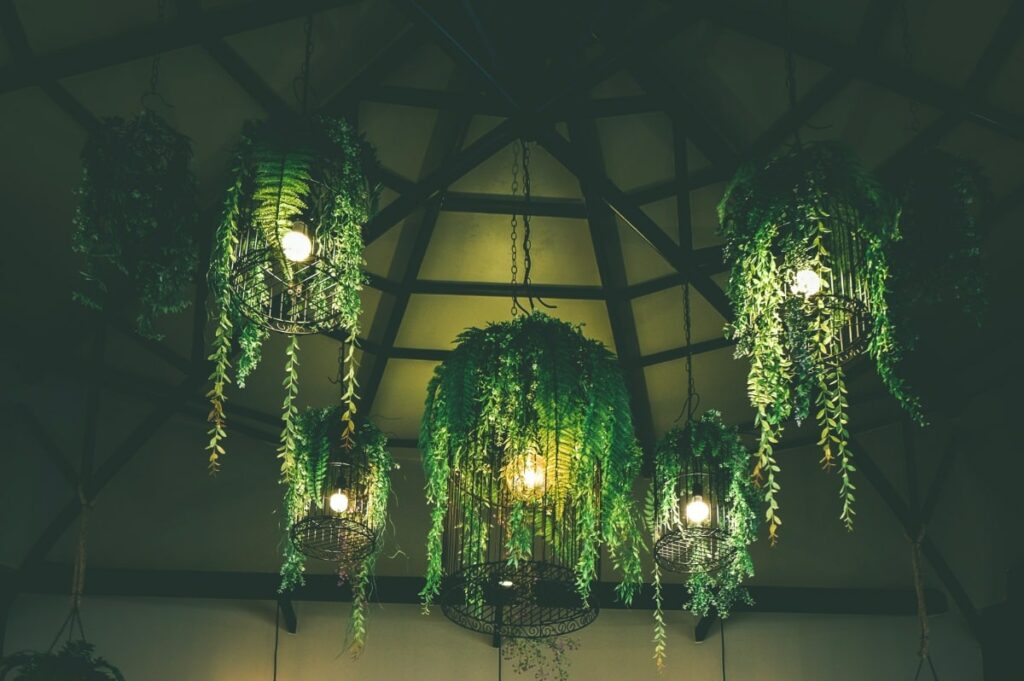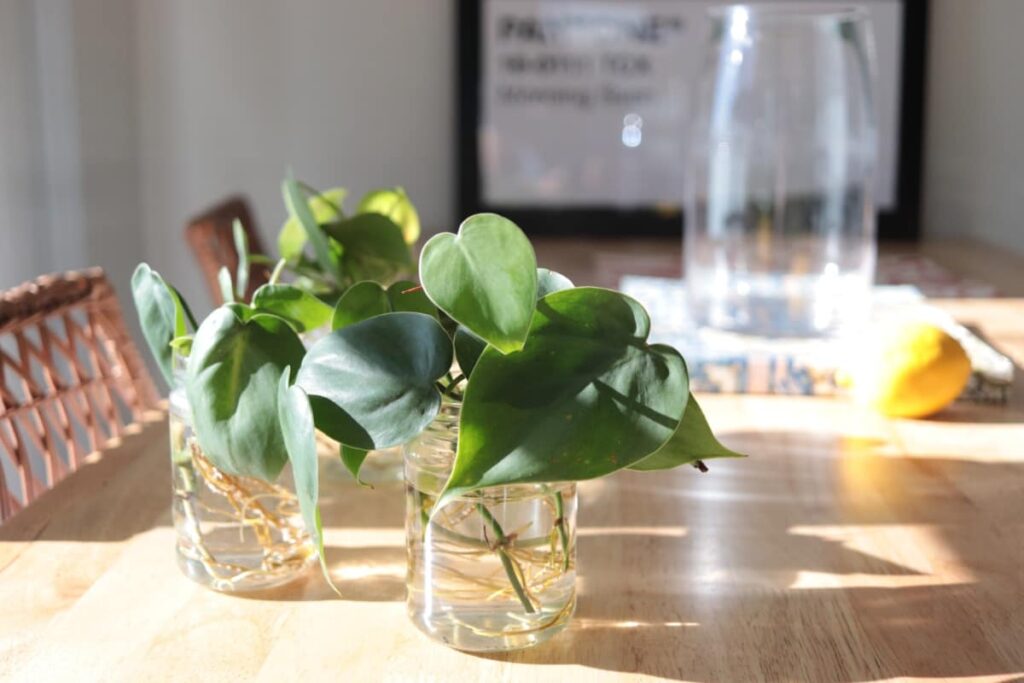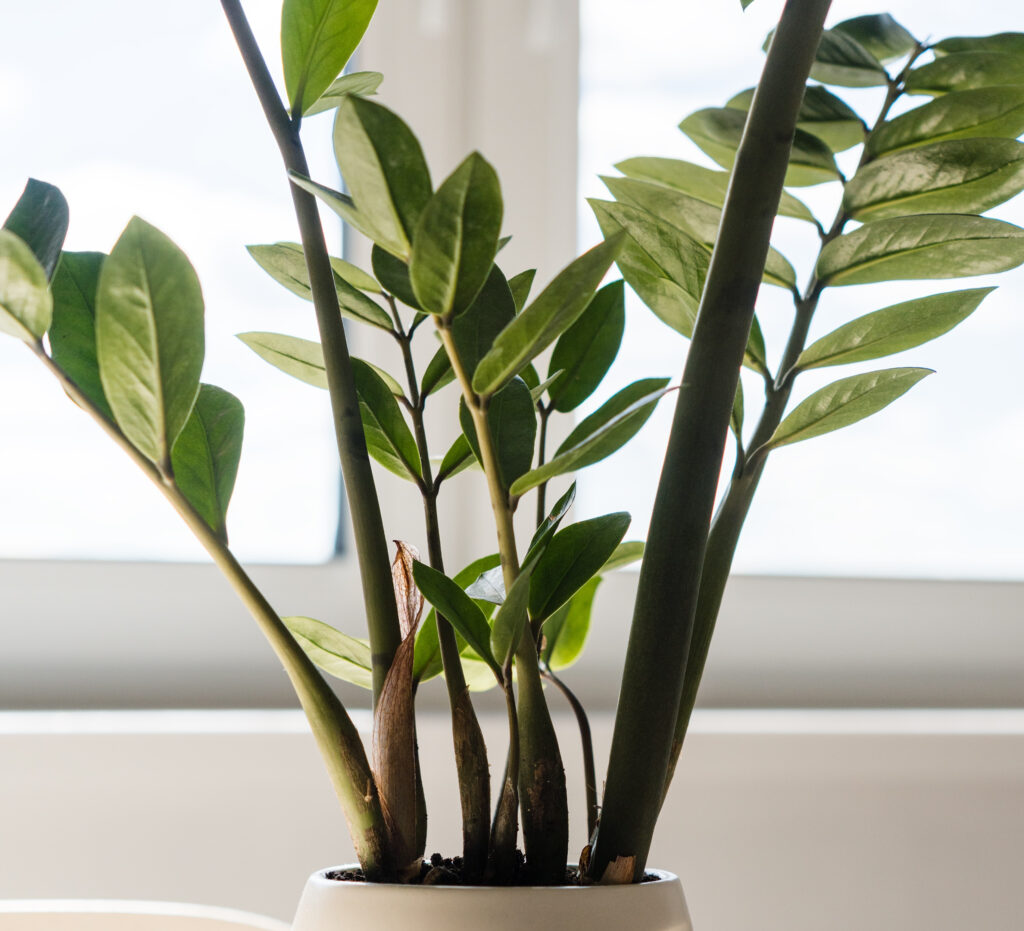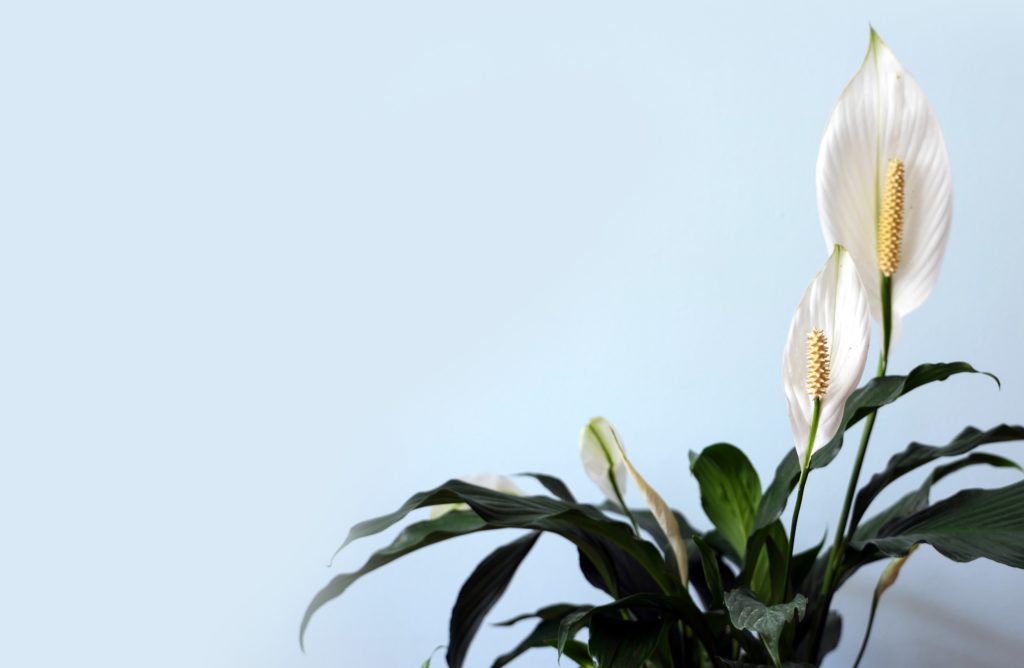Introduction to Bright Indirect Light
We’ve all heard the term “bright indirect light” as it relates to plant care. But what exactly is bright indirect light, and how can I tweak the lighting at home to make sure my plants are getting enough light energy? Whether you yearn for a cozy haven in your living room or a haven of productivity in your office, the art of understanding and creating bright indirect light holds the key to transforming the atmosphere of any environment. Dive in as we breakdown how to create the perfect bright indirect light so your houseplants can thrive and grow.
In this extraordinary guide, we uncover the secrets of various light sources and fixtures, and arm you with the practical wisdom needed to master the art of creating this ethereal illumination in diverse spaces. Whether you are a humble homeowner yearning to infuse your living space with ambiance or a visionary designer seeking to craft a welcoming sanctuary in a commercial setting, this guide shall be your beacon of knowledge, illuminating the path to harnessing the captivating power of bright indirect light.
What is Bright Indirect Light?

Bright indirect light is something that’s hard to define without using real-world examples. A great example of bright indirect light that I like to think about the light present when hiking through a forest during summer. Soft, filtered sunlight cascading through the lush and cool canopy of trees, creating a well-lit forest floor. This light isn’t too intense but keeps the forest floor lit well enough to easily read a book without straining. If you can picture this, you can picture bright indirect light.
The softness of this lighting is perfect for a vast majority of houseplants, making it so perfect for those plants that thrive in moderate to high light conditions. Very few plants can handle the direct exposure to the sun’s fiery gaze without getting burnt leaves. Conversely, there are few plants that prefer to grow in darker conditions. Bright indirect light walks this balance perfectly. A great rule of thumb: if you can comfortably read a paperback book with the current lighting in your room, the odds are that the conditions are right to support most plants that crave bright indirect lighting.
Bright Indirect Light Indoors
So, how do you create bright indirect light conditions if your home falls a little out of this lighting range? The easiest method is just to place your precious plants near a window with a sheer curtain, allowing just the right amount of natural light to filter through. A curtain will naturally diffuse any intense rays, while the window glass will make sure harmful UV rays can’t reach your plants (or you). Alternatively, you can whisk them away to a room blessed with an abundance of natural light. The key is to strike a balance bright enough to cast a shadow, yet gentle enough to avoid leaf bleaching or burning.
Bright Indirect Light Outdoors

If you live in a climate that’s great for growing plants outdoors year-round, or have warm summers that encourage your houseplants to flourish, keeping your plants outdoors can be a great way to encourage new growth and health. However, direct outdoor sun exposure is vastly different from soft indoor lighting. Plants that experience direct sun exposure, even for just a few moments, may get burned leaves and receive permanent damage.
How do you safely keep your plants outdoors? Make sure that any houseplants are kept on a covered porch, patio, under an umbrella table, or other structure that limits direct exposure to the intense rays from direct outdoor sunlight. When you first move plants outdoors, pay attention to the light they receive, and check on them multiple times a day to make sure that the sun’s movements in the sky don’t work to damage your plant.
By providing your plants with the gift of bright indirect light, you create an environment that nourishes their photosynthetic souls, encouraging lush foliage, vibrant blooms, and roots that could rival the mighty oaks. Now, let’s embark on a journey to explore the various ways in which you can create this wondrous bright indirect light in different indoor settings. Get ready to unlock the secrets of optimal lighting conditions for your precious plants
Identifying Suitable Locations for Bright Indirect Light

When it comes to the creation of bright indirect light in your space, there are a multitude of factors to take into account in order to identify suitable locations where this type of lighting can be achieved. The concept of bright indirect light is characterized by a gentle, diffused glow that is not harsh on the eyes and instead creates a warm and inviting atmosphere. Let’s delve into some of the key factors to consider when embarking on the task of identifying suitable locations for bright indirect light:
Natural Light Sources
The first step in this process is to thoroughly assess the natural light sources present in your space. It is important to seek out areas that receive an ample amount of sunlight during the day, while simultaneously avoiding direct exposure to the harsh rays of the sun. Examples of such areas could include windows adorned with sheer curtains or rooms that are adjacent to well-lit areas.
Reflective Surfaces
Another crucial aspect to take into consideration is the presence of reflective surfaces within your space. These surfaces play a pivotal role in enhancing the effect of bright indirect light by allowing it to bounce off and create a more pronounced impact. Light-colored walls, mirrors, and glossy furniture are all examples of surfaces that can contribute to this effect. It is essential to identify and make use of areas where these surfaces are present in order to maximize the overall impact of the light.
Obstructions
It is imperative to be mindful of any potential obstructions that may impede the flow of light. Objects such as furniture, curtains, or any other items that obstruct the path of light can significantly diminish the brightness and diffusion. Therefore, it is crucial to select a location that allows for unobstructed light to fill the space, ensuring that the desired effect is achieved.
Room Functionality
The functionality of the room should also be taken into account when identifying suitable locations for bright indirect light. Spaces that are designated for relaxation, reading, or entertaining can greatly benefit from the implementation of this type of lighting. Bedrooms, living rooms, and dining areas are often considered to be ideal spaces for creating a warm and cozy ambiance with the use of bright indirect light.
Personal Preference
Last but certainly not least, it is important to consider your personal preference and the specific mood you wish to create within the space. Bright indirect light can be utilized to highlight specific areas or objects, or it can be evenly distributed throughout the room. It is crucial to identify locations that align with your vision and desired atmosphere, as this will ultimately contribute to the overall success of the lighting design.
By taking these aforementioned factors into careful consideration, you will be able to successfully identify suitable locations within your space where bright indirect light can be effectively created. Always remember that the ultimate goal is to achieve a soft, diffused glow that enhances the overall ambiance and creates a welcoming environment for all who enter the space.
Assessing Natural Light Levels in Your Home

Understanding the natural light levels in your home is of utmost importance when it comes to crafting a luminous and alluring space. By meticulously evaluating the abundance of natural light at your disposal, you can make well-informed decisions on how to augment it and fabricate an environment that is bathed in radiant illumination. Take note of the precise areas within your abode that are graced with the direct caress of sunlight and the specific times at which this occurs. This meticulous observation will grant you invaluable insights into the intensity and duration of sunlight that graces the various rooms of your dwelling.
Uncover Obstacles
Engage in a quest to uncover any obstructions that may impede the ingress of natural light into your humble abode. These obstructions may manifest in the form of neighboring edifices, towering trees, or even the strategic placement of furniture. Take heed of those areas that are perpetually shrouded in shadow or are bereft of the sun’s gentle touch.
Quantify the Intensity of Illumination
Employ the aid of a light meter or a smartphone application specifically designed for this purpose to meticulously quantify the intensity of natural light in the diverse areas of your dwelling. This quantitative assessment will furnish you with a tangible measure of the light levels, enabling you to identify those areas that may necessitate supplementary illumination.
Ponder the Power of Orientation
Contemplate the profound influence that the orientation of your dwelling exerts on the quantum of natural light it receives. Rooms that face the south are generally blessed with copious amounts of sunlight throughout the day, while those facing north are graced with a softer, more diffused illumination. East-facing rooms are bestowed with the gentle caress of morning sunlight, while their west-facing counterparts bask in the warm embrace of afternoon rays. Take note of the orientation of each room, for it holds the key to unlocking its inherent potential for natural light.
Scrutinize Window Placement and Dimensions
Engage in a thorough evaluation of the placement and dimensions of the windows that adorn each room. Windows that are larger in size and strategically positioned to face the path of the sun will facilitate the ingress of a greater volume of natural light. Ponder whether any windows necessitate resizing or if the addition of supplementary windows would serve to maximize the infusion of natural light.
Harness the Power of Reflective Surfaces
Take heed of any reflective surfaces that grace your dwelling, such as mirrors or glossy finishes. These surfaces possess the remarkable ability to bounce natural light around the room, engendering an ambiance that is imbued with a heightened luminosity and radiance.
Evaluate the Existing Illumination
Undertake a comprehensive assessment of the current lighting fixtures that grace your dwelling and the manner in which they interact with the natural light. Ascertain whether any fixtures obstruct the ingress of natural light or if they can be adjusted to enhance its presence.
By diligently adhering to these steps, you shall acquire a profound and comprehensive understanding of the natural light levels that grace your humble abode. Armed with this knowledge, you shall be empowered to fashion a space that is resplendent with brightness and suffused with an inviting atmosphere that beckons all who enter.
Creating Bright Indirect Light: Tips and Techniques
Embrace the Power of Natural Light
Ah, the beauty of natural sunlight! It’s like a gift from the heavens above. To create that mesmerizing bright indirect light, strategically position your windows to allow the glorious rays of the sun to flood your room. This will create a soft and gentle illumination that spreads like a warm hug throughout your space.
The Art of Choosing the Right Light Fixtures

Now, let’s talk about artificial lighting. Oh, the possibilities are endless! When it comes to achieving that dreamy bright indirect light, selecting the right fixtures is like finding the holy grail. Look for fixtures that have diffusers or frosted glass shades, my friend. They are the secret sauce that helps scatter the light and reduce direct glare. Pendant lights, wall sconces, and floor lamps with adjustable shades are like the superheroes of creating indirect light. Oh, and don’t forget about those LED bulbs with a high color rendering index (CRI). They ensure accurate color representation and give off a bright, natural glow that will make your heart skip a beat.
Reflective Surfaces
Prepare to be dazzled! Incorporating reflective surfaces into your space is like adding a sprinkle of stardust to your lighting setup. Mirrors, glossy furniture, and metallic accents are like the magicians that bounce light around the room, creating a brighter and more evenly lit environment. Place those mirrors strategically opposite windows or light sources, and watch the magic unfold as they reflect and amplify the natural or artificial light.
Layer Your Lighting
Let’s add some depth and dimension to your space, shall we? To achieve that jaw-dropping, visually appealing space, it’s time to embrace the art of layering your lighting. Combine different light sources, my friend. Overhead fixtures, task lighting, and accent lights are like the ingredients that create a symphony of light. By incorporating various light levels and angles, you can effectively distribute the light throughout the room, banishing any dark corners or harsh shadows to the abyss.
Dare to Be Different with Light Placement
Oh, the power of placement! It’s time to break free from the shackles of convention and explore new horizons. Avoid the mundane by not positioning lights directly above or in front of your seating areas. That’s so yesterday! Instead, let’s get creative. Place lights at intriguing angles or hide them behind furniture to create a softer and more diffused illumination that will leave your guests in awe. And hey, have you heard of wall-washing techniques? It’s like painting with light! Direct that light towards a wall, let it bounce off, and watch as it spreads like wildfire throughout the room. Now that’s what I call bright indirect light!
The Temperature of Light
Brace yourself for a temperature check! The color temperature of your light bulbs can make or break the ambiance of your space. Are you ready to set the mood? For a bright and energetic atmosphere, go for bulbs with a higher color temperature (around 5000K). They will make your space come alive! But hey, if you prefer a warmer and cozier feel, opt for bulbs with a lower color temperature (around 2700K). It’s like wrapping yourself in a cozy blanket of light. Experiment with different temperatures, my friend, until you find that perfect balance that suits your preferences and the purpose of the room.
My fellow light enthusiasts, creating bright indirect light is an art form that combines the best of natural and artificial lighting techniques. By harnessing the power of natural sunlight, selecting the right fixtures, incorporating reflective surfaces, layering your lighting like a pro, daring to be different with light placement, and considering the temperature of light, you can achieve a well-lit space that will leave everyone in awe. So go forth, adapt these mind-blowing tips and techniques to suit your specific needs and preferences, and bask in the glorious ambiance that bright indirect light can bring to your surroundings
Why is Bright Indirect Light Important for Houseplants?

When it comes to the health and growth of your beloved houseplants, the right amount and quality of light are absolutely essential. It’s like their own little power plant, converting light energy into chemical energy. But here’s the thing – they need the perfect balance of intensity and diffusion. Enter bright indirect light! Unlike its harsh cousin, direct sunlight, this type of light provides a gentle and consistent source of energy for your plants, preventing any leaf burn mishaps.
Preventing Leaf Damage
Picture this – houseplants chilling in the understory of a lush forest, basking in the filtered light that seeps through the canopy. That’s the kind of environment they thrive in. And guess what? Bright indirect light mimics this natural setting, shielding your plants from the scorching and bleaching effects of intense sunlight. So, say goodbye to sad, damaged leaves and hello to vibrant green foliage!
Minimizing Heat Stress
Sunlight not only brings the light, but it also brings the heat. And that can be a real problem for houseplants, especially those that prefer cooler temperatures. But fear not! Bright indirect light swoops in to save the day, reducing the risk of heat stress and creating a more comfortable environment for your green buddies. It’s like a temperature regulator, preventing any overheating disasters.
Versatility and Adaptability
Bright indirect light is like a chameleon – it can adapt to the needs of a wide range of houseplants. Whether you’re rocking tropical plants, succulents, or flowering varieties, this type of lighting has got you covered. It’s the perfect balance of light that caters to the diverse needs of different plant species. So, no matter what kind of indoor gardening enthusiast you are, bright indirect light is your go-to choice!
Promoting Growth and Flowering
Brace yourself for some serious growth and blooming action! Bright indirect light is the ultimate cheerleader for your houseplants. It stimulates healthy growth and encourages those beautiful blooms to show off. With its consistent and moderate light levels, this type of lighting gives your plants the energy boost they need to develop lush foliage and vibrant flowers. It’s like a spotlight on their full potential!
Bright indirect light is the superhero your houseplants need. It ensures optimal photosynthesis, prevents leaf damage, minimizes heat stress, and promotes growth and flowering. By embracing the importance of this type of lighting, you’re creating the perfect environment for your indoor green companions to thrive and bring beauty to your home.
Common Houseplants that Thrive in Bright Indirect Light
When it comes to the realm of bright indirect light, there exists a plethora of houseplants that not only tolerate this particular lighting condition but rather thrive in it. These remarkable plants are the epitome of perfection for those areas within your humble abode where direct sunlight is limited, yet a substantial amount of brightness still manages to seep through. Without further ado, let us delve into the realm of these popular houseplants that will undoubtedly flourish in the realm of bright indirect light.
Snake Plant (Sansevieria)

First, we have the Snake Plant, scientifically known as Sansevieria. Renowned for their unwavering resilience and adaptability to various lighting conditions, including the ever-elusive bright indirect light, these plants boast long, upright leaves that come in a mesmerizing array of shades encompassing the entire spectrum of green and yellow. Not only are Snake Plants visually captivating, but they also possess the remarkable ability to purify the air, making them an invaluable addition to any room.
Pothos Golden (Epipremnum aureum)

Next on our list is the Pothos Golden, or Epipremnum aureum, a versatile and low-maintenance houseplant that thrives effortlessly in a wide range of lighting conditions, including the enigmatic realm of bright indirect light. With its heart-shaped leaves, which exhibit an enchanting palette of green hues, and some varieties even showcasing captivating variegated patterns, the Pothos is a true marvel. Its trailing vines make it an ideal choice for hanging baskets or adorning shelves, adding a touch of elegance to any space it graces.
ZZ Plant (Zamioculcas zamiifolia)

Moving forward, we encounter the enigmatic ZZ Plant, scientifically known as Zamioculcas zamiifolia. This particular plant is a popular choice for those seeking a low-maintenance houseplant that can withstand the trials and tribulations of low light conditions. However, it is worth noting that the ZZ Plant also thrives exceptionally well in the realm of bright indirect light. With its glossy, dark green leaves exuding an aura of sophistication, the ZZ Plant effortlessly injects a sense of elegance into any space it inhabits. Furthermore, it possesses the remarkable ability to purify the air, eliminating toxins and contributing to a healthier indoor environment.
Chinese Evergreen Silver Queen (Aglaonema)

Now, let us turn our attention to the Chinese Evergreen Silver Queen, scientifically known as Aglaonema. This exquisite houseplant thrives effortlessly in the realm of bright indirect light, showcasing its resplendent variegated leaves adorned with patterns of silver, green, and occasionally even red. The Chinese Evergreen is renowned for its adaptability to various lighting conditions, making it a popular choice among both novice plant enthusiasts and seasoned veterans alike.
Peace Lily

Moving along, we encounter the Peace Lily, scientifically known as Spathiphyllum. These captivating plants are not only celebrated for their elegant white flowers but also for their uncanny ability to thrive in the realm of bright indirect light. Preferring slightly more shade than their counterparts, Peace Lilies are the epitome of perfection for areas blessed with filtered sunlight. Moreover, these remarkable plants contribute to an improved indoor air quality by diligently removing toxins such as formaldehyde and benzene.
Spider Plant

Last but certainly not least, we have the Spider Plant, scientifically known as Chlorophytum comosum. These resilient plants possess an unparalleled adaptability, effortlessly tolerating a wide range of lighting conditions, including the ever-elusive bright indirect light. With their long, arching leaves adorned with captivating green and white stripes, Spider Plants are a sight to behold, capturing the attention of all who lay eyes upon them. Furthermore, these remarkable plants possess the unique ability to produce “spiderettes,” which can be propagated to create new plants, perpetuating their captivating presence.
With the right care, attention, and a touch of green-thumb finesse, these houseplants will not only illuminate your space but also contribute to a healthier and more vibrant indoor environment. By providing the right lighting conditions for your houseplants, you’ll go a long way to ensuring their long-term health and growth potential.
Frequently Asked Questions
What is bright indirect light?
Bright indirect light refers to the type of light that is not directly exposed to the sun’s rays but still provides ample brightness for plants or indoor spaces. It is a diffused light that is gentle and evenly distributed, creating a soft glow without causing harsh shadows or intense heat.
Why is bright indirect light important for plants?
Bright indirect light is crucial for many plants as it mimics their natural habitat. It provides the necessary energy for photosynthesis while protecting them from the potential harm of direct sunlight. This type of light allows plants to thrive by promoting healthy growth, vibrant foliage, and blooming flowers.
How can I create bright indirect light indoors?
To create bright indirect light indoors, you can place your plants near a north-facing window where they can receive bright, indirect sunlight throughout the day. Alternatively, you can use sheer curtains or blinds to filter the sunlight and create a diffused glow. Another option is to use artificial lighting, such as fluorescent or LED grow lights, positioned at an appropriate distance to provide the desired brightness.
Can I use artificial lighting to create bright indirect light?
Yes, artificial lighting can be an excellent option for creating bright indirect light indoors. LED grow lights or full-spectrum fluorescent lights are particularly effective in providing the right balance of light for plants. It is important to position the lights at an appropriate distance from the plants to avoid causing any damage or stress.
Which plants thrive in bright indirect light?
Many houseplants thrive in bright indirect light. Some popular examples include pothos, snake plants, ferns, peace lilies, and spider plants. These plants have adapted to lower light conditions in their natural habitats and can flourish in the gentle, diffused light provided by bright indirect light.
What are the signs that my plant is not receiving enough bright indirect light?
If your plant is not receiving enough bright indirect light, it may exhibit certain signs. These can include leggy or elongated stems, pale or yellowing leaves, lack of flowering, or overall stunted growth. If you notice these signs, it may be an indication that your plant needs to be moved to a brighter location or provided with additional artificial lighting.

